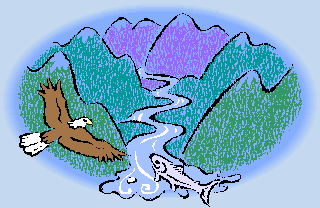Water News for March 2012
While you were celebrating the 100th birthday of Oreo cookies, a lot of important things happened in the world of water. Read on to hear all about it.
One of the very strangest lakes in existence is the so called "Berkely Pit," at Butte, Montana. The giant, toxic lake is the result of an abandoned copper mining operation.
Another Consequence of Global Warming. A NASA study found that as temperatures warm, melting ocean ice triggers an interaction between sunlight, salt in the water, and a chemical element called Bromine. When these mix, the salty ice releases bromine into the air and starts a cascade of chemical reactions called a “bromine explosion.” These reactions rapidly create more molecules of bromine monoxide in the atmosphere. Bromine then reacts with a gaseous form of mercury, turning it into an ozone-eating pollutant that falls to Earth’s surface.
The Crowders Creek Wastewater Treatment Plant south of Gastonia isn’t just focusing on filtration. Along the 104 acres where it sits, the open and undeveloped land has been enhanced to provide optimal safe habitats for wildlife in conjunction with the use for wastewater treatment.
Quit Smoking by Drinking Water
From an article about how to quit smoking: in the Spring 2012 print issue of HAO magazine: "I read in a newspaper article that drinking a lot of water could help. I began to carry a plastic bottle with a straw attached all the time. It worked! First, it substituted the sucking reflex that one gets from smoking. Second, the more water one drinks, the more fluid is passed from the body. I think it helped flush the nicotine out of my body at a good rate. Finally, it was easy and cheap. It worked for me, and I haven't had a smoke in 20 years."
Is There A New Superfund Site Near You?
The U.S. Environmental Protection Agency (EPA) is adding nine new hazardous waste sites that pose risks to people’s health and the environment to the National Priorities List (NPL) of Superfund sites, and is proposing to include 10 additional sites. Superfund is the federal program that investigates and cleans up the most complex, uncontrolled or abandoned hazardous waste sites in the country. Find out if one of the new Superfund sites is in your town.
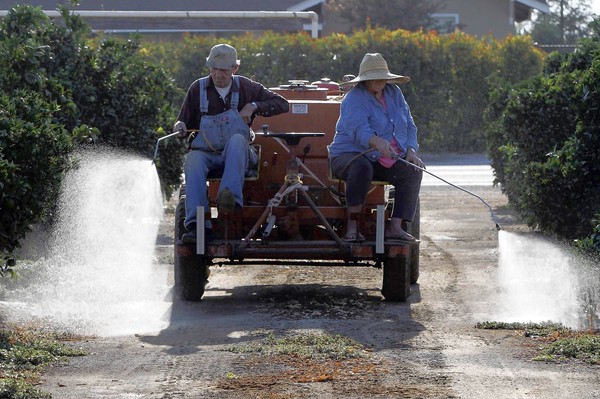 |
|
An orange grove near Visalia, Calif. is sprayed with chemicals. Nitrate contamination is largely the result of nitrogen leaching into aquifers from fertilizers and manure applied to cropland. High nitrate levels have been linked to cancer and reproductive disorders and can be lethal to infants.
Nitrate contamination of groundwater in some of the state's most intensely farmed regions has grown worse in recent decades and will continue to spread, threatening the drinking water supplies of more than 250,000 people, according to a new study.
The LA Times has done an extensive study of nitrate contamination of California farming areas.
How to get rid of nitrates in your drinking water? Reverse osmosis.
|
The Multi-Pure Corporation has a new president.
Charlottesville, VA will be disinfecting its water with chloramines starting in 2014, and the town's decision to convert provoked some controversy. Read all about it in the Charlottesville Tomorrow.
The U.S. Environmental Protection Agency joined Delta Faucet Co., and Bell Plumbing & Heating to provide Renaissance 88 Apartments, a Colorado Coalition for the Homeless apartment building in Thornton, CO, with a water-saving makeover. The retrofits and leak repairs taken at the apartment complex will save 560,000 gallons of water per year, enough to fill fifty backyard swimming pools.
A search is on for the source of PCE contamination in Laconia, NH.. PCE is a compound commonly used in dry cleaning. More about PCE from the Occasional's website.
Two trespassers, a male and female, were pulled out of the water in a sump where they were they had slipped in to swim at the city of Sacramento’s Fairbairn Water Treatment Plant on the American River. The woman was hospitalized after the rescue.
The Water Quality Association's Annual Convention was held in Las Vegas in early March. Attendance was up 26% over 2011.
Fluoride Is Everywhere. Does It Make Sense to Keep Adding It To Water Supplies?
Most are aware that fluoride is intentionally added to a growing number of foods and products ostensibly for the protection of children's teeth. The following article, excerpted from Dr. Joseph Mercola's email newsletter, reveals a surprising source of fluoride that you might not be aware of.
Dr. Mercola's Introduction
Jeff Green has been an activist in the movement to eliminate a toxic fluoride from your water supply for the past 15 years.With more than 60 percent of U.S. water supplies currently fluoridated, chances are you're one of the 170 million Americans who drink fluoride on a daily basis. In a previous interview, Green delved into the sordid history that made water fluoridation a reality in the first place. If you missed it, I highly recommend taking the time to watch it now.
But fluoridated water is not the sole source of harmful fluoride. Here, the discussion focuses on some of the lesser known sources of fluoride exposure.
A Primary Source of Fluoride: Your Food!
While toothpaste and drinking water would appear to be the leading sources of fluoride exposure, probably the most common source of exposure is actually non-organic foods! The reason for this is because of the widespread use of fluoride-based pesticides.
According to Green, non-organic food could account for as much as one-third of the average person's fluoride exposure!
This is important, as many people are under the mistaken assumption that by avoiding fluoridated water, they've eliminated the primary source of fluoride. But if you're still eating conventionally-farmed foods, your fluoride exposure is still likely very high.
"Cryolite is actually sodium aluminum fluoride... This sodium aluminum fluoride is especially effective at killing bugs," Green explains. "It's also very sticky, so when they spray it, it's more likely to stick on your produce, unless you're... really working at trying to get it off of it. As time has gone on, and... everybody said fluoridation must be really great, they ramped up the amount of residue [allowed on food] from these fluoride-based pesticides. They have petitioned the EPA to be able to allow it, and they come out with larger and larger [allowable] amounts."
Amazingly, based on the assumed safety of such fluoride-based pesticides, iceberg lettuce can now contain a whopping 180 parts per million (ppm) of fluoride—that's 180 times higher than what's recommended in drinking water!
"The assumption is that on a head of lettuce, you're going to peel off those outer layers and you're not going to eat much of that. Whether you do or not; that's up to you... Romaine lettuce and what we call leaf lettuce are allowed to have 40 ppm, with the assumption that it's down inside there and you're going to have to do more cleaning. But because it's so sticky, it's almost impossible [to wash off] unless you go back to the old ideas of the Fuller brush... produce brushes that you... scrape this stuff off with. The majority of people don't make that extra effort to be able to take it off."
Citrus fruits are allowed to be contaminated with 95 ppm's of sodium aluminum fluoride. Potatoes may have 22 ppm's on the outside and up to two ppm's on the inside. Raisins can have up to 55 ppm's. But of all the foods, grapes are perhaps one of the foremost sources of fluoride exposure.
Bet you would not have guessed that!
Grapes are a major source of fluoride because, first of all, they're heavily sprayed with cryolite, and second, white grape juice is typically used as the base, or filler juice in all sorts of juice drinks. So if you drink any kind of juice on a regular basis, you're probably getting hefty doses of cryolite, i.e. fluoride-based pesticide... Cereals, mechanically deboned meats, and black or green tea are a few other sources that may surprise you.
"Wheaties for example was measured at 10 parts per million," Green says. "Shredded Wheat: 9.4 parts per million. Why is it so high? One, they use pesticides on the grains. Two, they use [fluoridated] water... So you actually have higher concentrations than you ever found in the water where it was being made.
As for mechanically deboned meats, the source of the fluoride is the animal itself, which is exposed in the same manner as humans—through feed and water—which then comes out during the manufacturing process. Black and green teas are naturally high in fluoride, even if organically-grown without pesticides. This is because the plant readily absorbs fluoride thorough its root system, including naturally-occurring fluoride in the soil. According to Green, there are reports of people who have developed crippling skeletal fluorosis from drinking high amounts of iced tea alone.
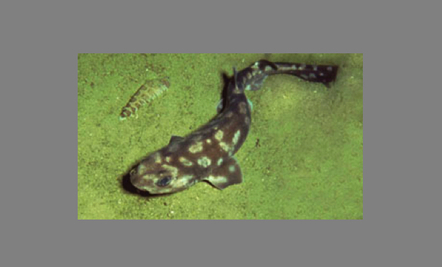 |
A New Shark. Scientists discovered a new species of spotted, bottom-dwelling shark near the Galapagos Islands. It was first observed from a submersible vessel and named bythaelurus giddinsi. The new species is a cat shark and was seen at a depth of 1,600 feet. Each of the specimens that were collected is less than two feet long and all have pale spots in random, unique patterns. |
A 10 meter long whale shark — the world’s largest fish — emerged from the sea just off the Pakistani coast. Unfortunately, the fish was dead.
Water treatment giant Culligan, facing
a $900 million loan debt, is expected to declare bankruptcy soon.
Goldman Sachs and GE have launched the Aqueduct Alliance, a "consortium of water experts from the private and public sectors, NGOs and academia exploring water risk." The term “water risk” refers to stresses on water resources that pose threats to society and business — as well as opportunities for competitive advantage through effective water risk management, according to the group's press release. (Beware of giant corporations out to save the world.)
Texas Comes in Fourth in "Most Polluted Waterways"Contest
Although Houston topped the list in a recent "America's Fattest Cities" listing, Texas as a whole was able to do no better than 4th in a Texas Monthly study of the nation's most polluted waterways. Below is Sonia Smith's March 22, 2012 posting on the matter:
Texas waterways are the fourth most polluted in the nation, according to a new report from Environment Texas. Companies released some 14.6 million pounds of industrial pollutants and toxic chemicals into Texas’ waterways in 2010. Only waterways in Indiana, Virginia, and Nebraska received more industrial pollution.
“Texas’ waterways are a polluter’s paradise right now. Polluters dump 14.6 million pounds of toxic chemicals in Texas’ lakes, rivers, and streams every year,” Luke Metzger, director of Environment Texas, said in a release. “We must turn the tide of toxic pollution by restoring Clean Water Act protections to our waterways.”
Who is the worst offender? According to the report, Sanderson Farms Inc., a chicken company that handles everything from “production” to processing, dumped 1.5 million pounds of pollution—mostly nitrate compounds—into nearby streams.
Environment Texas drew up the report using water discharge data from the Environmental Protection Agency. Metzger pointed out that this report comes out as the Clean Water Act turns forty.
Texas Waterways that Received the Most Industrial Pollution in 2010:
-
Houston Ship Channel
-
Brazos River
-
Cottonwood Branch
-
Corpus Christi Inner Harbor
-
Tankersley Creek
-
Tehuscana Creek
-
Corpus Christi Bay
-
Cedar Creek
-
Neches River
-
Industrial Ship Channel
 |
| This plane, aptly named "Exposure," took aerial photos that led to the exposure of a Dallas County meat packing plant that was discharging a river of pig blood into the Trinity River. |
California schools have adopted a variety of strategies to cope with the lowering of the arsenic allowable to 10 ppb.
Activist Linda Stewart has pestered Baltimore water department officials for years and has become famous citywide as the "water bill woman." This month, "... the city released an audit that showed that 92 percent of 70,000 accounts flagged for possible problems were likely overbilled — and most of the homes examined in the audit have received no credits for the excessive charges. Baltimore's Department of Public Works plans to issue more than $4.2 million in water bill refunds. For Stewart, the revelations served as a vindication."
Grand Island, NB is spending $3 million to remove uranium from its drinking water.
A Louisiana town is concerned that overpumping of water by industries along the Mississippi are causing saltwater intrusions into the aquifer that threaten the drinking water of Baton Rouge and other cities.
"Nature may have found a way to dispose of the huge amounts of plastic garbage, which has been increasingly accumulating in the oceans. A small bacteria feeding on it has been discovered. This may be a boon or a bane for the aquatic environment.The bacteria was discovered through electron microscopy on plastic items sampled at the Sargasso Sea, an area in the North Atlantic, where debris tends to stack up due to local currents." Full Story.
The water supply system of Bellingham, MA is studying ways to cope with growing problems with E.coli, iron, and manganese.
At least 60 Wisconsin community water suppliers are dispensing untreated water.
The Texas Supreme Court ruled that groundwater can be considered the personal property of the landowner. (This decision could have far-reaching consequences in the effort to conserve and manage the state's water resources.)
 |
A Few Things You Should Know about Copepods
by Pure Water Annie
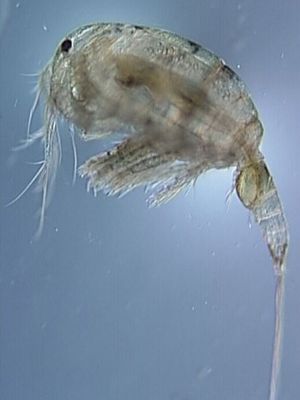
Copepods may not be high on your list of water issues unless your religious beliefs require use of kosher water. But non-Jews may also feel better about drinking and bathing in water that isn't teeming with little one-eyed crustaceans. |
It is easier for a rich man riding a camel to pass through the eye of a needle than for a copepod to pass through a 20 micron filter.--Tiger Tom, Pure Water Gazette Columnist.
Copepods include several varieties of small crustaceans found both in the sea and fresh water. They live in the oceans, in ponds, in puddles, on plants, under wet forest leaves, attached to fish or corals--almost anywhere it's wet..
Copepods are typically 1-2 mm long, with teardrop-shaped bodies and big antennae. They're so small that their bodies are almost totally transparent. In some areas copepods reach one centimeter in size, but they are usually small enough to be invisible or barely visible to the human eye.
Although there has been of late the impression that there is an "infestation" of copepods taking place, truth is that copepods have always been around and they are important citizens of our ecosystem. It's just that we're becoming more aware of them. Public water reservoirs are also part of our ecosystem, so copepods could be expected to inhabit them. According to one source:
Reservoirs are essentially man-made lakes, and contain a regular ecosystem, including algae, copepods [and other micro-organisms, such as water fleas (Cladocera), rotifers, nematodes, ostracodes, amphipods, etc.] and fish. These are not infestations, but rather essential components of a healthy ecosystem. Copepods feed on algae, which would otherwise multiply and deplete the water of dissolved oxygen. They in turn are food for the fish. Planktonic copepods are present in reservoirs, lakes, and other bodies of slowly moving water throughout the world.
Copepods have been especially an issue in New York City. The reason is that NYC's water is very clean. Because it is so clean, the city is exempt from federal and state rules that require filtration of municipal water supplies. NYC water is chlorinated and fluoridated, but it otherwise goes to homes essentially in the condition it was in when it left the reservoir. To elaborate, cities that are required to filter their water, remove copepods with their filters, but in clean water cities like New York, San Francisco, and Boston the tiny creatures remain in the unfiltered water all the way to the consumer's home.
Copepods normally pose no risk to health in water from clean reservoirs, although they have been associated with such waterborne diseases a cholera in areas in South America and elsewhere where water is consumed untreated by chlorine. As for the religious issue, here's how Wikipedia explains it:
The matter of copepods in the water supply has raised a problem for Jewish people who observe Kashrut in that copepods, being crustaceans, are not kosher, and are not small enough to be ignored as non-food microscopic organisms (since some specimens can be seen with the naked eye). The discovery of copepods in the New York water supply in the summer of 2004 in particular caused significant debate in rabbinical circles and caused many observant Jews to buy filters for their water.
Copepod Filters
In parts of Africa, guinea worms attach themselves to copepods and cause infections when when ingested by the native population. This is prevented by use of nylon mesh as a filter. The nylon filter is approximately 150 microns, but it is tight enough to filter out the copepods (and consequently the guinea worms).
According to one source, "An old cotton sari, folded, creates a smaller effective mesh size (approximately 20-μm). This should be small enough to remove all zooplankton, most phytoplankton, and thus a large proportion of the cholera in the water (99%, according to laboratory studies)." The nylon mesh proved to be almost as effective as the folded sari.
The moral is that copepods aren't hard to filter out. Any good 20 micron filter is more than tight enough to grab them if you want to remove them from water entering your home.
 |
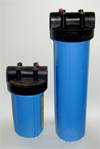 |
| The woman at right is preparing a folded sari filter over a water jar. The sari makes a 20 micron filter. |
Modern cartridge-style filters with a 20 micron cartridge provide assurance of copepod-free water. |
 |
Numerical Wizard B. Bea Sharper ferrets out the watery facts that Harper's misses
Plastic Bags: The Bane of the Oceans |
Number of plastic bags used each year worldwide -- 1 trillion.
Number of plastic bags used daily in China -- 1 billion.
Number of plastic bags used each minute worldwide -- 1 million.
Number of years it can take a single plastic bag to degrade -- 1,000
Number of years it can take a married plastic bag to degrade --1000.
Millions of tons of plastic bags and wraps that were discarded in a single year, 2008 -- 3.5
Annual US consumption of single-use plastic bags --100 billion.
Cost to US retailers for a year's worth of single use bags --$4 billion.
Rank of plastic bags among the most-common types of ocean refuse --2.
Rank of cigarette butts among the most common types of ocean refuse --1.
Estimated pieces of plastic floating in each square mile of ocean -- 46,000.
Estimated number of plastic bags accumulated by average family in a trip to the grocery store--4.
Estimated years it takes a plastic bag to degrade in a landfill--1,000.
By BCC and CNN estimate, percentage of plastic bags that are actually recycled -- 0.5% to 3.0%.
Percentage of the world's plastic that ends up each year in the ocean -- 10%.
Percentage of this that finds its way to the ocean floor (where it will perhaps never degrade) --70%.
Source of plastic bag statistics.
|
